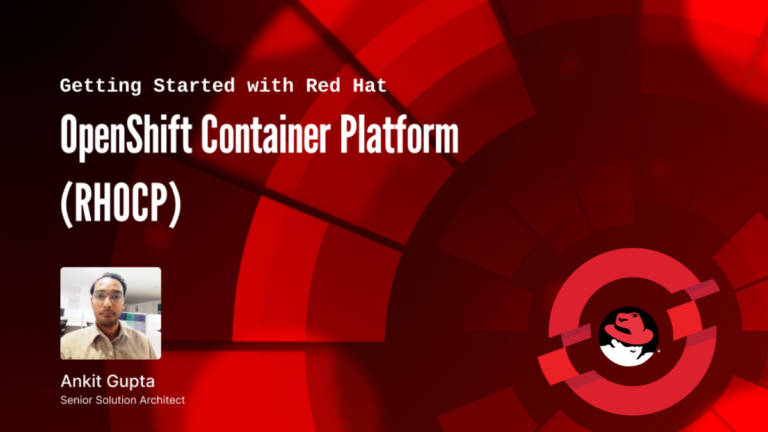To Understand Open Shift, will Discuss In “5W1H” (What, When, Where, Why, Who, How) Points.
What is Red Hat Open Shift Container Platform?
Open Shift Container Platform is a hybrid cloud foundation PaaS for building & scaling containerized (CaaS) applications.
RHOCP is a comprehensive solution for container orchestration and management, offering various components and tools to simplify the deployment and operation of containerized applications in a scalable and efficient manner.
It is a product of Red Hat, Container Orchestration Platform integrates services to reduce the friction of developing, modernizing, deploying, running, and managing applications.
It also provides a user-friendly console to view and manage all your clusters across multiple deployments.
When was Developed?
OpenShift inception traces back to Red Hat’s purchase of Makara in November 2010 ,specializing in a platform as a service (PaaS) built upon the foundation of Linux containers & it has since evolved into an enterprise-ready solution.
OpenShift Container Platform was developed as a result of Red Hat’s acquisition of CoreOS, a company that specialized in container technologies, in 2018.
Red Hat combined CoreOS’s expertise with its own experience in Kubernetes, Linux, and cloud computing to create OpenShift Container Platform, which was first released in 2019.
OpenShift Container Platform is based on Kubernetes and therefore shares the same technology. It also incorporates other open source projects such as, Istio, Prometheus, Grafana, etc.
Where Deployed?
OpenShift Container Platform can be deployed on various computing platforms:
On-Premise: Company deploy RHOCP on OpenStack or VMware. their own servers within data centers.
Public Cloud: OpenStack on a public cloud service provider’s e.g AWS, Azure, IBM Cloud, and Google Cloud Platform.
OpenShift Container Platform delivers a single, consistent container platform anywhere on RedHat Enterprise Linux
Why Created?
OpenShift Container Platform was created to address need for scalable & efficient platform for managing containerized applications.
Simplify the deployment process of containerized applications.
Improve developer productivity through integrated tools.
Provide a reliable, enterprise-ready container orchestration solution.
Enhance scalability and automation for container-based workloads.
Developing and managing containerized applications in a hybrid cloud.security, privacy, compliance, and governance requirements.
Container Platform offers automated upgrades, developer-friendly workflows, and enterprise-grade support.
Who Uses Open Shift?
Open Shift Container Platform is used by a wide range of organizations, including:
Enterprises modernize their application infrastructure.
DevOps teams for streamlined container management.
Developers aiming to accelerate application development and deployment.
IT administrators responsible for maintaining container environments.
Organizations across industries, such as finance, healthcare, and e-commerce.
How Does Red Hat Open Shift Work?
An overview of how Open Shift Container Platform works and highlights its key components:
1. Container Runtime: Deploys & manages containers on worker nodes. These containers are the runtime environments for applications and are based on OCI-compliant images, which are binary representations of applications.
2. Worker Nodes : Server nodes running multiple Workload & Application containers.
3. Pods: Pods are the smallest deployable unit. They consist of one or more collocated containers that share resources like volumes and IP addresses, allow applications to be grouped together and managed as a single unit.

4. Key Components:
Red Hat Enterprise Linux CoreOS: minimal OS on hosts container runtime & Kubernetes cluster services.
Installer: Automates the installation & configuration of OpenShift Container Platform clusters
Kubernetes Operators: Package, deploy, & manage Kubernetes applications in automated & streamlined manner.
Console: A web-based interface for managing cluster resources and applications.
CLI: A command-line tool for interacting with Container Platform clusters and applications.
Registry: A secure and scalable image registry for storing & distributing container images across clusters.
Router: Handles inbound traffic & routes to appropriate pods based on service names
Service Mesh: Provide tools for connecting, securing, monitoring & managing microservices in uniform way.
Monitoring: Collects metrics & alerts from cluster & applications using Prometheus and Alert Manager,
Logging: Collects logs from cluster & application with Elasticsearch, Kibana for centralized log management.
Metering: Tracks resource usage & generates reports for billing purposes .
Product Developed by Industry Leader’s Similar to Open Shift Container Platform
Container orchestration and management platforms :
1. Google Kubernetes Engine (GKE): Google’s managed Kubernetes service that provides a robust container orchestration platform with features like automated scaling, monitoring, and high availability.
2. Amazon Elastic Kubernetes Service (EKS): Amazon Web Services (AWS) managed Kubernetes service, offering a highly scalable and secure container orchestration platform with deep integration into the AWS ecosystem.
3. Microsoft Azure Kubernetes Service (AKS): Microsoft Azure’s managed Kubernetes service, designed for easy deployment, management, and scaling of containerized applications on Azure infrastructure.
4. Mirantis Kubernetes Engine: This is a container platform that runs on the Mirantis enterprise Linux operating system and Kubernetes.
5. VMware Tanzu Kubernetes Grid (TKG): Kubernetes distribution by VMware that enables organizations to run and manage Kubernetes clusters across multiple clouds and on-premises infrastructure.
Conclusion
In conclusion, we have explored the fundamental concepts, architecture, and key components of RHOCP, empowering you with the knowledge needed to leverage its capabilities.
RHOCP flexibility, scalability, and robust features make it a valuable tool for managing containerized applications in both on-premises and cloud environments.
In a rapidly evolving technological landscape, RHOCP is a valuable Tool that can enhance your ability to develop, deploy, and manage containerized applications effectively. As you continue to explore and work with Red Hat OpenShift Container Platform, you’ll discover new ways to optimize your container workflows, improve application agility, and stay ahead in the world of modern software development.

